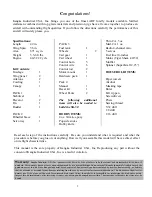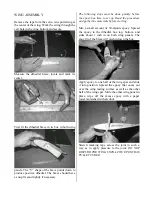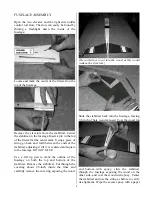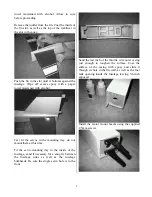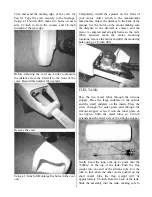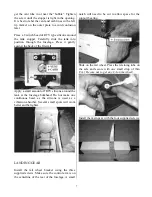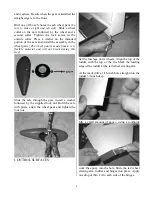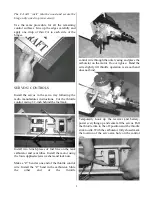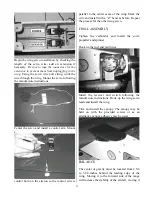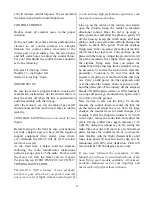
aft will increase control response. We recommend
the forward position for initial flight tests.
CONTROL THROWS
Double check all controls move in the proper
direction
With your radio on, center all trims and adjust the
clevises so all control surfaces are straight.
Measure the control surface movement at the
widest part of each surface. Use the servo horns
and bell crank holes to adjust the control throw.
For your first flights the control throws should be
set to the following:
Elevator 1/2-inch up / down
Rudder 1 ½- inch right / left
Aileron 1/4-inch up / down
MOTOR SET UP
Be sure the motor is properly broken in using the
manufacture instructions. Set the throttle throw to
shut the motor off when the trim is pulled down
and idles reliably with the trim up.
After the motor is set, run one tank of gas at full
throttle, measure how much time it takes to run the
tank dry.
CONGRADULATIONS you are now ready for test
flights.
Before leaving for the field be sure your batteries
are fully charged and you have all the required
support equipment {fuel, starter, glow driver,
ect.}.Although the SK-50 will fly well in wind,
wait for a nice day.
At the field have a helper hold the airplane,
following the radio manufactures instructions
perform a range check of the radio. Do this with
the motor off, start the motor and do it again.
Perform this test
EVERY TIME YOU GO TO FLY!
TRIMING BASIC FLIGHT
The SK-50 is NOT a trainer. A true aerobatic
aircraft, it goes only where you point it and will
not recover to level flight without control input. If
you do not have high performance experience seek
the help of someone who does.
Line up on the center of the runway and slowly
open the throttle, using the rudder to maintain
directional control. Once the tail is up apply a
little up elevator and allow the plane to gently lift
off the runway. Keep the climb angle and turns
shallow until you reach a safe altitude. Reduce the
throttle to about 60% power. With the airplane
flying away from you adjust the radio aileron trim
tab till the wing stays level. Turn and line up the
plane with the runway. Adjust the elevator trim till
the plane maintains level flight. Once again with
the airplane flying away from you adjust the
rudder trim till the fuselage tracks straight {it may
be necessary to correct the aileron trim after this
procedure}. Continue to fly and trim until the
aircraft is tracking well, land before the fuel runs
out. Carry a little power on final approach until
over the end of the runway, then cut power to idle,
hold the plane just off the runway till the airspeed
bleeds off and the plane settles on. If the landing is
too long add power go around and try again, don’t
try to force it to the ground.
Now its time to zero out the trims. To do this
measure the control location, center the trim tab
on the radio and adjust the servo horn for large
changes, the control clevis for small changes. For
example if after the flight the rudder is 3/16 inch
to the right, center the radio trim and adjust the
clevis till the rudder once again measures 3/16
right. By doing this whenever you fly, setting the
radio trims at center will result in a well-trimmed
plane. Increase the control travel, as you become
more familiar with the flight characteristics until
loops take about 50 feet and knife edge can be
maintained with 80% stick deflection. Final roll
rate should be 300-360 degrees per second.
If you have followed the procedures in this
Manuel you will now be rewarded with one of the
finest flying sport models available. All primary
aerobatic maneuvers are at your fingertips and
the aircraft will perform them with ease.
12


